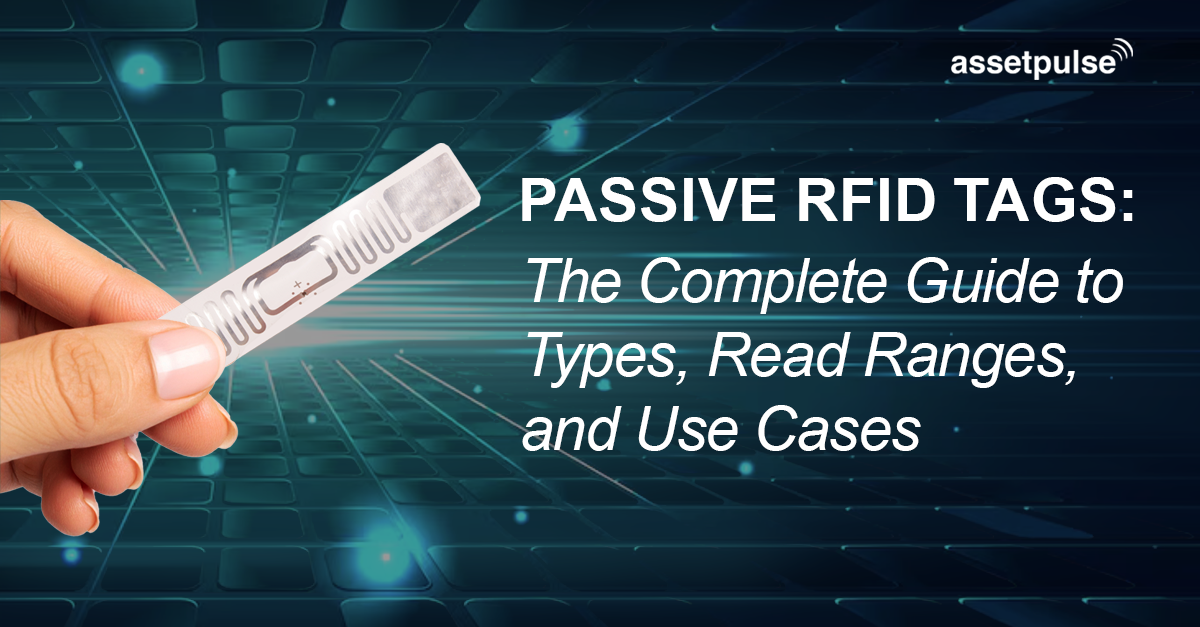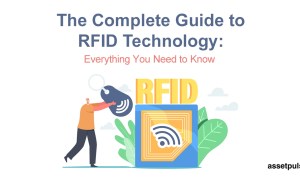Every organization that still relies on manual barcode scans or spreadsheets knows the pain of missing assets, inventory discrepancies, and time-consuming audits. Passive RFID tags eliminate these challenges by automating asset identification and tracking. In this guide, you’ll learn exactly what passive RFID tags are, explore the different tag types and read ranges, discover real-world applications across industries, and get clear criteria for choosing the perfect tag for your environment.
Ready to see how passive RFID tags cut inventory hours?
Discover industry-leading techniques to use passive RFID tags efficiently!
Get Free ConsultationWhat is a Passive RFID Tag?
A passive RFID tag is a tiny, battery-free transponder consisting of an integrated circuit (IC) and an antenna. When an RFID reader emits radio waves at a specific frequency, the tag’s antenna captures that energy, powers the IC, and sends back its unique identifier. Because they don’t need onboard power, passive RFID tags are:
- Cost-effective for large-scale deployments
- Low-maintenance-no battery replacements
- Durable, with lifespans often exceeding 10 years
- Small and flexible, available as inlays, cards, labels, or rugged hard tags
Types of Passive RFID Tags
Passive RFID tags come in three primary frequency categories, each suited to different use cases:
| Frequency Band | Typical Read Range | Common Uses |
| LF (125-134 kHz) | Up to 10 cm | Animal tracking, access control, metal environments |
| HF (13.56 MHz) | 10 cm – 1 m | NFC applications, library books, ticketing, healthcare |
| UHF (860-960 MHz) | 1 m – 12 m (up to 20 m in ideal conditions) | Supply chain & logistics, inventory, pallet tracking |
- LF Tags: Offer reliable reads around metal and liquids but have shorter read ranges.
- HF/NFC Tags: Support standardized protocols (ISO 14443/15693), enabling smartphone -based reads.
- UHF Tags: Deliver the longest range and fastest read rates, making them ideal for conveyor-belt scanning, dock door portals, and wide-area asset tracking.
Within each band, you’ll find specialized on-metal tags, wet-inlays, high-temperature tags, and tamper-evident labels, allowing you to match the tag form factor to your application’s environmental demands.
Passive RFID Tag Read Ranges
RFID tag read range isn’t a fixed number-it varies based on:
- Tag sensitivity: Higher-performance ICs can respond to weaker reader signals.
- Reader power & antenna design: Powerful readers and optimized antennas extend range.
- Environmental factors: Metal surfaces and liquids can detune antennas, reducing range.
- Orientation & placement: Tags aligned toward the reader yield longer reads.
| Factor | Impact on Read Range |
| Tag sensitivity | ± 10-50% variation |
| Reader transmit power | Up to FCC/ETSI limits (e.g., 1 W ERP in UHF) |
| Metal/liquid interference | May cut range by 30-70% without on metal tuning |
| Tag orientation | Optimal vs. edge-on placement can differ by several meters |
Conduct an onsite RFID site survey with tag prototypes to measure real-world read zones. That way, you avoid unpleasant surprises during full-scale deployment.
Curious which passive RFID tags work best in various environments?
Learn passive RFID tag types tailored for different environments!
Get Free ConsultationUse Cases Across Industries
- Retail & Apparel Inventory
- Bulk-scan clothing racks and shipments to reduce out-of-stock incidents
- Accelerate cycle counts from hours to minutes
- Manufacturing Work-in-Progress
- Track WIP components on the factory floor in real time
- Automate line changeovers with RFID-driven process triggers
- Healthcare Asset Management
- Locate infusion pumps, wheelchairs, and surgical tools instantly
- Ensure compliance with sterilization protocols via RFID asset tracking
- Library & Document Tracking
- Streamline check-in/check-out of books, media, and files
- Improve inventory accuracy and reduce misplaced items
- IT Equipment & Data Center Assets
- Monitor servers, network gear, and spare parts
- Integrate RFID readers at data center entrances for audit trails
- Logistics & Warehouse Operations
- Automate pallet verification at dock doors and cross-docking stations
- Enable hands-free picking and packing workflows
How to Choose the Right Passive RFID Tag
Selecting the optimal passive RFID tag requires balancing technical specs with practical constraints:
| Selection Criterion | What to Consider |
| Frequency & Read Range | Do you need short-range NFC reads or long-range UHF corridor scanning? |
| Environmental Durability | Temperature extremes, chemical exposure, or moisture resistance |
| Substrate/material | On-metal tags for metal assets, wet-inlays for aqueous environments |
| Form Factor & Size | Label vs. hard tag vs. card: mount points and available space |
| Compliance & Standards | Passive RFID tags must comply with standards like those set by the FCC in the U.S. and ETSI in Europe. Note that UHF frequency bands vary by region (e.g., 902-928 MHz in the U.S., 865-868 MHz in Europe), so ensure your tags and readers match local regulations. |
| Cost per Tag | Budget vs. performance: higher-sensitivity tags cost more but reduce reader density |
| Integration Needs | Data format compatibility with your WMS, ERP, or IoT platform |
Want expert help selecting passive RFID tags for your needs?
Get industry-leading tag selection and placement best practices!
Get Free ConsultationChecklist:
- Define your read zone requirements.
- Identify environmental hazards.
- Pilot multiple tag types in real conditions.
- Analyze tag performance data and adjust reader settings.
- Scale with the option to switch tag types as needs evolve.
Best Practices for Successful Implementation

- Start Small with a Pilot
Test tags, readers, and software workflows on a limited scale before full rollout. - Optimize Reader Placement
Use directional antennas and choke rings to focus read zones and minimize stray reads. - Calibrate Power & Sensitivity
Balance transmit power to avoid interference while ensuring reliable reads. - Train Your Team
Provide hands-on training for operations staff on tag placement and reader operation. - Monitor & Maintain
Schedule regular audits of reader performance and tag integrity.
By following these steps, you’ll achieve a smooth, scalable passive RFID deployment that drives ROI from day one.
Next Steps
Passive RFID tags unlock a new level of asset visibility, inventory accuracy, and operational efficiency across industries. By understanding tag types, real-world read ranges, and practical selection criteria, you’ll be ready to transform manual tracking into a hands-free, data-driven process.
Ready to secure your assets and streamline operations?
Schedule a Free Consultation with AssetPulse solution experts and see how passive tags can streamline your workflow.
FAQs
How do passive RFID tags work?
Passive RFID tags work by capturing energy from radio waves emitted by an RFID reader. The tag’s antenna transforms electromagnetic energy into electrical power, enabling the microchip to send stored data back to the reader. No internal battery is required since they draw power entirely from the reader’s signal.
What are active and passive RFID tags?
Active RFID tags have their own internal battery and can actively broadcast signals over long distances (up to 100+ meters). Passive RFID tags have no battery and rely on the reader’s energy to function, with shorter read ranges but much lower costs and longer lifespans since there’s no battery to replace.
What are passive RFID tags and how do they work?
Passive RFID tags are battery-free transponders consisting of a microchip and antenna. When a reader emits radio waves, the tag captures this energy to power its chip and transmit back its unique identifier. They’re cost-effective, maintenance-free, and can last over 10 years without replacement.
What is the difference between passive and active RFID tags?
The main differences are: Power source – passive tags use reader energy while active tags have batteries; Read range – passive tags work up to 1-12 meters, active tags up to 100+ meters; Cost – passive tags cost much less; Lifespan – passive tags last 10+ years, active tags need battery replacement every 3-4 years; Size – passive tags are smaller and more flexible.
What are the main applications for passive RFID tags?
Common applications include retail inventory management, supply chain tracking, asset management in healthcare and manufacturing, library book tracking, access control cards, contactless payments, work-in-progress monitoring on factory floors, and IT equipment tracking in data centers.
What is the read range of passive RFID tags?
Read ranges vary by frequency: Low Frequency (LF) tags work up to 10 cm, High Frequency (HF/NFC) tags reach 10 cm to 1 meter, and Ultra-High Frequency (UHF) tags can be read from 1-12 meters, with up to 20 meters possible in ideal conditions with powerful readers.
What types of data can passive RFID tags store?
Passive RFID tags typically store anywhere from 64 bits to 1 KB of data, including a unique identifier, product details, serial numbers, manufacturing dates, and basic tracking information. Tags can be read-only (pre-programmed) or read-write (allowing data updates). Some advanced tags can also store sensor data like temperature readings.
What frequencies do passive RFID tags operate on?
Passive RFID tags operate on three main frequency bands: Low Frequency (125-134 kHz) for close-range applications, High Frequency (13.56 MHz) for NFC and medium-range uses, and Ultra-High Frequency (860-960 MHz) for long-range tracking. The exact UHF frequencies vary by region due to regulatory differences.
How secure are passive RFID tags?
Passive RFID tags have basic security features including unique identifiers and some encryption capabilities. However, they’re generally less secure than active tags due to power constraints. Security risks include unauthorized reading and potential cloning, though modern tags include improved encryption protocols and authentication features to enhance protection.
What are the advantages and disadvantages of passive tags?
Advantages: Low cost, no battery maintenance, long lifespan (10+ years), small size, flexible form factors, can read multiple tags simultaneously, work through materials, and enable automation. Disadvantages: Rely on reader power (need more/stronger readers), slower data rates than active tags, very limited memory (often only an EPC), can’t initiate communication (no real-time tracking), performance suffers near metal/liquids, and weaker security.




